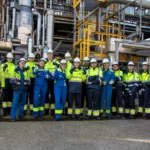Chemical industry snapshot
An integrated industry
In 2023 Norway’s chemical, oil refining and pharmaceutical industry had sales of NOK 175 billion (€15,2 billion), of which NOK 145 billion were exports (83%). The sector employed 13,800 full-time equivalents, and generated NOK 454 billion (€3,9 billion) of added value. Official statistics treat chemicals, oil refining and pharma as a single industry.
Powered by natural resources
Traditionally, the Norwegian industrial economy has been centered around natural resources like fisheries, the forest, shipping, mining, and metallurgical industry. Hydro-electric power is the foundation of a thriving process industry of which the chemical industry forms an important part. The ascent of the petroleum sector has clearly benefitted chemical companies and strengthened mechanical engineering, maritime suppliers and ship building.
Targeting exports
The chemical industry is highly export-oriented and thus exposed to global competition. Though the industry benefits from access to hydro power and is environmentally friendly, competitiveness is curbed by high wage costs and a fluctuating currency. The EU is by far industry’s most important export market (see above). Norway is fully integrated in the internal market through the EEA-agreement and adheres to all relevant rules and regulations, including REACH as well as competition legislation.
Norway and Norwegian chemical industry are firm supporters of free and fair international trade as supported by the WTO.
Between river and sea
Chemical plants are chiefly located along the coastline, close to hydroelectric power plants and deep, ice-free harbours. There are local clusters of chemical and other process industries – in industrial parks or in clusters operating across regional borders. International companies have a strong ownership position within the chemical sector and other process industries in Norway.
From basic to biotech
Norwegian chemical production centers around basic inorganics, fertilizers, petrochemicals, polymers, and some specialties and bio-refineries. The pharmaceutical industry is relatively small.
Biotech start-ups are located around the universities, e.g., in Oslo, Trondheim and Tromsø.
Universities are found in four of the 10 counties where numerous process industry companies are located. The University of Technology and Science in Mid-Norway has the closest links with the chemical sector.
How are we doing?
Strengths
- Unique combination of national energy resources: petroleum, hydropower, and other renewables (wind power and biomass)
- 98% renewable electricity
- An electricity surplus, but war in Ukraine has disrupted European power supply, with high prices in Southern Norway in 2022/24.
- High energy and resource efficiency – expertise in reducing GHG-emissions
- Small environmental footprints
- Well-educated labour force with appropriate industrial skills
- Good cooperation between companies and unions
- Lean organisations
- High level of employment and standards of living
- NGOs and politicians back hydro-powered process industries
- Socially sustainable production with strong focus on health and safety
- Globally integrated and export intensive
Challenges
- Enelrgy prices are high compared to non-European rivals (notably China)
- Expensive feedstock
- Access to competence
- Location on the fringe of Europe
Our contribution to a competitive Europe
Neutral enabling policies
Norway does not have an explicit sectoral industrial policy strategy: government sets horizontal framework conditions (research, energy, education, infrastructure, environment).
A climate change advantage
The chemical industry and the energy intensive industries in Norway are at the forefront of GHG abatement, having reduced its emissions by 40% since 1990. A tri-partite collaboration between industry, unions and the authorities has further strengthened this ambition and measures will be brought forward in the years to come. A climate partnership for the energy intensive industries is in the making.
The government’s climate ambitions are aligned with EU. Participating in the EU ETS, the EU carbon price constitute the main climate-related instrument for chemical companies. Norwegian process industries receive free allowances and carbon cost compensations. These instruments are key to guard against carbon leakage. For industry outside of ETS, there is a CO2 tax, aiming for a level playing field.
Funding for pioneering technologies
Enova, an enterprise managed by the Norwegian State, supports pilot and demonstration installations and deployment of new climate technology. Environmental technology development and deployment are also supported, along with SME projects and energy efficiency projects. Norwegian enterprises also have access to Horizon Europe and the ETS Innovation Fund.
Supporting knowledge and innovation
Norway has a broad range of national programmes supporting R&D in both private and public sector. From an industry perspective, the long-term R&D priorities are ocean space, energy, climate, sustainability, emerging technologies – including advanced production and materials – and infrastructures. Industrial companies and academia co-operate in R&D initiatives through national research centres, such as the SFI and the FME programmes, a new national scheeme named Green Platform and smaller R&D projects such as the industrial innovation projects (IPN).
Generation capacity/Power exchange
The energy crisis and expected price uncertainties within the European and Nordic markets brings into question how this will affect industry. Prospects of increased hydrogen, batteries, ammonia, offshore wind production etc. adds to the challenges in assessing this. Nevertheless, the clear presumption is that industrial production in Norway, will continue to be close to 100% based on renewable energy for the foreseeable future, being in line with the Green Deal industrial objectives.














